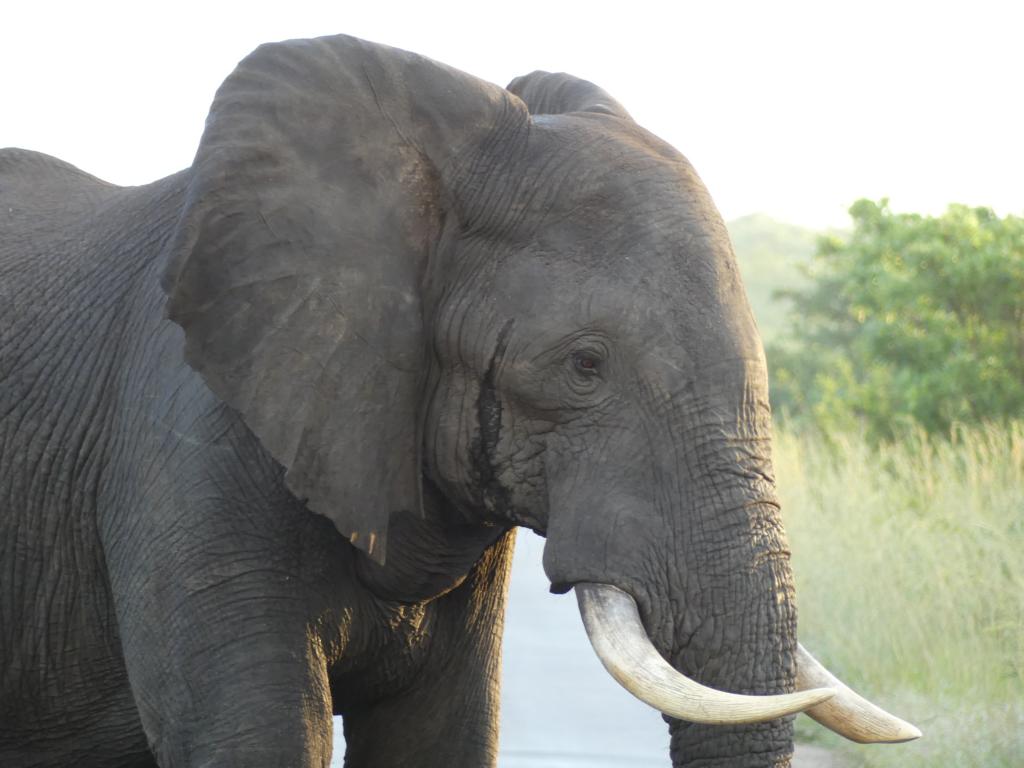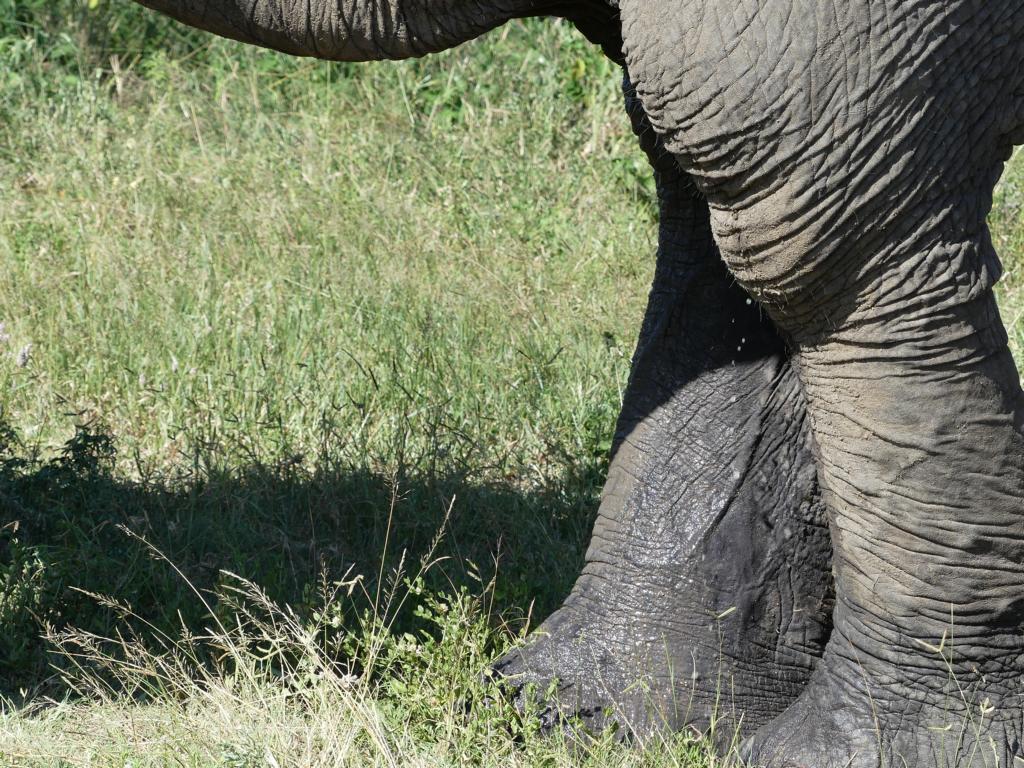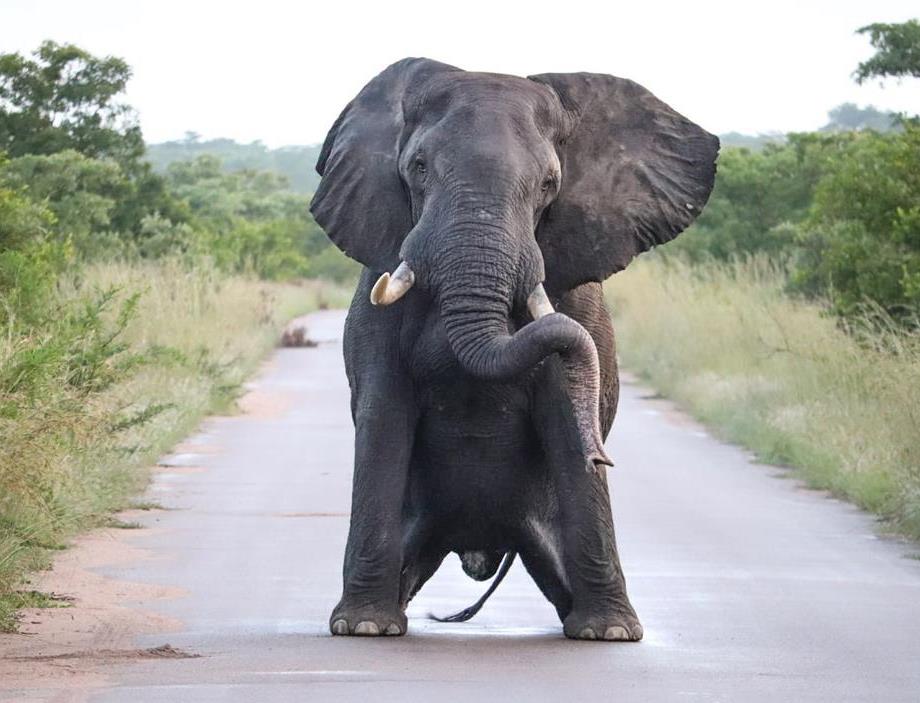Musth is a condition of elevated testosterone levels in the blood of elephants. African elephant (Loxodonta africana) bulls come into their first musth when they are between 15 – 17 years old. The length of the musth depends on the age of the elephants. In young ones, it may last only days. Whereas in bulls between 35 – 60 years of age, it can take between four to seven months a year. Musth starts mainly in the rainy season when many cows are coming into oestrus. During musth, elephant bulls are impulsively traveling long distances. Which drives them away from areas of cows they could be related to.
Secreting from the temporal glands


If an elephant bull is in musth, his temporal glands are oozing an oily yellow-green substance. This substance can be seen as a dark stream of liquid on both sides of the head. And the smell of this substance lingers around for a long time. But – this secretion is not a clear and unique indication of musth. Also, cow elephants are oozing from the temporal glands, although considerably less than bulls, and only when they are getting stressed. Therefore, the head shape has to be considered. In African elephants, bulls have a round forehead, and cows have distinctive sharp-edged foreheads.
Dripping urine

Bulls in musth constantly drip urine, which smells intensively of concentrated urine. Whereas elephants in normal condition are smelling like fresh hay. On roads or tracks their constant urine dripping can be seen on the surface. And this dripping urine is wetting the inside of their hind feet. This further propagates the smell and stains the inside of the hind feet shiny and dark. Due to this constant dripping of urine, a bull elephant is losing up to 350 liters of urine per day. He therefore has to drink an elevated amount of water to replenish the lost liquid.
At the height of musth, elephants are so full of testosterone, that they are completely overpowered by its effects. Sometimes even their hind feet are not holding up anymore. They don’t know what to do with their trunk and some of them are getting aggressive.
When meeting an elephant bull in musth in the bush…
Generally, if an elephant has torn outer fringes of earlobes, it is a strong indication that this elephant is aggressive. The reason for that is, that he was charging other animals through the bush. And by that not taking care of thorny trees or bushes, and ripping up his ear fringes on those occasions.

Therefore, if being in the bush and smelling elephant urine, the immediate action should be to walk as fast and noiseless as possible downwind. And if possible, in the opposite direction. Elephants have an excellent sense of smell, very good hearing, and rather poor eyesight. The smell is always very keen. Hearing is often impaired by their noises during foraging and they mainly see movements. If you are standing still – they normally can’t see you.
If running into a lone elephant bull who is in musth, the only way to avoid a likely attack is by moving downwind. And the noise has to be cut down as much as possible and movements have to be camouflaged. In many cases, this will not be possible anymore if already stumbled into the elephant. Especially if the distance is too close to move out undetected.
Elephant mock attack and/or serious attack
If an attack cannot be avoided, there remains as a last resort the use of a rifle. It is obligatory to carry such for trails in dangerous game areas in most Southern African countries. There are clear and strict procedures for licensed trail guides on how to handle such a situation. Because often an elephant attack is just a mock attack.
At such a mock attack, an elephant spreads out its ears and lifts the trunk and trumpets when running towards you. But he will stop some meters in front of you if you are not running away. When running away, he will chase you down. A serious attack is one if the elephant remains quiet when running towards his aim. If he holds his head up, folds his ears back, and curls his trunk under his mouth for protection. The only way to stop him would be shooting. The big problem is that a mock attack can change within seconds into a serious one.
Personal experiences with elephants in musth

Once, in the Kruger NP, our car was chased by an elephant in musth for more than one hour. He constantly attacked us – and we constantly tried to get past him. Luckily it was very early morning on a sideroad, and no other cars were around. Otherwise, he would have smashed us. He was so full of testosterone, that his hind legs frequently gave way. And sometimes he was nearly sitting on the road.
On another occasion at Timbavati PGR our small trekking group was chased by an Elli in musth. We only got away, as our mentor sneaked us out of the wind and Ellis’s sight. And finally, we were able to get away unharmed from him.
Lessons learned about elephant bulls in musth
- Meeting elephant bulls in musth on foot in the bush has to be avoided at all costs.
- Elephants in musth can be smelled early.
- When on foot, urine-dripping lines on roads or other smooth surfaces call for an immediate turnaround to move in the opposite direction.
- When getting attacked: Never run – with the exception, if there is a serious attack and no rifle is on hand, running may be the only slim last chance to survive.
Further readings about Dangerous Game in Southern Africa on this website:
African buffaloes are dangerous
Lion behavior – so different by day and night
Spotted beauties: Leopards in Southern Africa
Danger posed by Nile crocodiles
Spotted hyenas are successful hunters
Why are Hippos dangerous on land?
.




